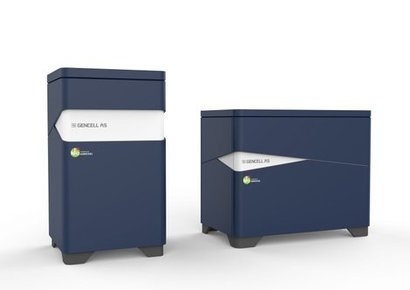
The $1.7 million grant is funded by the US Department of Energy, the Israel Ministry of Energy and Israel Innovation Authority. As part of the joint research and development, AETC and GenCell worked together to develop a low-temperature catalyst for cracking ammonia into hydrogen and nitrogen.
The unique catalyst is used by the GenCell A5 Off-Grid Power Solution to create hydrogen-on-demand from ammonia, the world's second most-produced industrial chemical. Ammonia is readily available and is less expensive than diesel fuel in many countries throughout the world. The use of ammonia as a fuel enables the GenCell A5 solution to provide cost-effective, ultra-reliable, noise-free and weather-independent power for off-grid and poor-grid telecom base stations at a lower OPEX than diesel generators.
The traditional process of dissociating ammonia into hydrogen and nitrogen gases is carried out at temperatures that often exceed 700˚C. Because of this, ammonia-cracking employs costly metal alloys and high-nickel steel components that are resistive at such high temperatures. The requirements for high energy input and costly components make traditional ammonia-cracking an expensive process. AETC’s new nanomaterial-based catalyst allows the endothermic process to occur at temperatures not exceeding 500˚C and makes ammonia-cracking more cost-effective.
“We are very excited to have worked on this project with GenCell Energy” said Dr. Maya Barsukov, President & CEO at AETC. “This project has allowed us to produce a range of innovative, nanotechnology-based materials with a profound impact on the fuel cell industry. These technologies may also have great potential as catalysts for other industries such as oil and gas refining and industrial chemical synthesis.”
Gennadi Finkelshtain, CTO at GenCell, added that fuel cells were initially developed to supply power for the American and Russian space and naval programme, but, like other bulletproof space and military technologies, fuel cells have historically been a bit on the expensive side, a fact which has prohibited their mainstream adoption. GenCell’s partnership with AETC through the BIRD Energy programme has enabled its A5 Off-Grid Power Solution to create hydrogen-on-demand from low-cost ammonia. This technological breakthrough has allowed the company to create a uniquely affordable primary power fuel cell solution that can replace diesel generators for rural telecom and rural electrification.
The BIRD Foundation promotes collaboration between US and Israeli companies in various technological fields for the purpose of joint product development. In addition to providing conditional grants for approved projects, the foundation assists by working with companies to identify potential strategic partners and facilitate introductions.
Image: The GenCell A5 off-grid power solution, including the A5 fuel cell generator (right) and the unique ammonia reformer (left) – Courtesy of GenCell
For additional information:
American Energy Technologies Company (AETC)
Israel-United States Binational Industrial Research and Development (BIRD) Foundation

